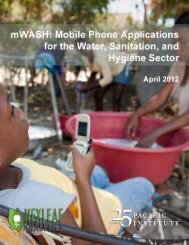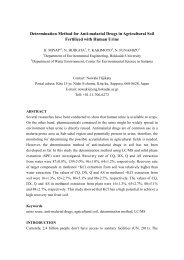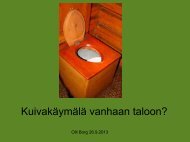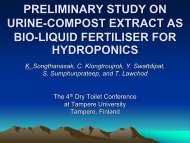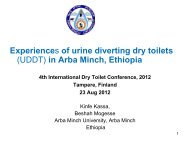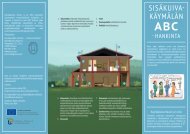Evaluation of social and cultural acceptance of the biotoilet system
Evaluation of social and cultural acceptance of the biotoilet system
Evaluation of social and cultural acceptance of the biotoilet system
Create successful ePaper yourself
Turn your PDF publications into a flip-book with our unique Google optimized e-Paper software.
sanitation alternative. More recently, its promotion has moved towards <strong>the</strong> installation <strong>of</strong> dry<br />
toilets. Two types <strong>of</strong> dry toilets are mainly found, prefabricated made <strong>of</strong> glass fiber <strong>and</strong><br />
constructed on site made <strong>of</strong> masonry (Fig. 3). These technologies are onsite sanitation<br />
solutions; <strong>the</strong>refore, <strong>the</strong> <strong>biotoilet</strong> <strong>acceptance</strong> was compared with that <strong>of</strong> such alternatives.<br />
2. Preparation <strong>of</strong> a reliable survey format to assess <strong>the</strong> socio<strong>cultural</strong> <strong>acceptance</strong> <strong>of</strong> <strong>the</strong><br />
<strong>biotoilet</strong>.<br />
Complete survey format is not included in this paper because <strong>of</strong> its extension. However,<br />
Table 1 summarizes <strong>the</strong> survey format contents. As seen, <strong>the</strong> survey was divided into 9<br />
sections <strong>and</strong> <strong>the</strong> number <strong>of</strong> questions per each section is indicated in <strong>the</strong> right column <strong>of</strong> <strong>the</strong><br />
table.<br />
3. Selection <strong>of</strong> <strong>the</strong> communities where <strong>the</strong> survey was conducted.<br />
According to <strong>the</strong> National Institute <strong>of</strong> Statistics, Geography <strong>and</strong> Informatics (INEGI, initials<br />
in Spanish, 2006), in <strong>the</strong> Municipality <strong>of</strong> Dolores Hidalgo 7,081 households (26.4% <strong>of</strong> <strong>the</strong><br />
total, 37,195 inhabitants) did not have access to conventional WC connected to <strong>the</strong> sewage<br />
or septic tank. 6,719 households are located in rural areas. In some <strong>of</strong> <strong>the</strong>se households dry<br />
toilets are installed, but still 473 households concentrated in 49 communities don’t have any<br />
sanitation <strong>system</strong>.<br />
Table 1. Contents <strong>of</strong> <strong>the</strong> survey format.<br />
Section Description No. <strong>of</strong> questions<br />
I General data <strong>of</strong> <strong>the</strong> user 8<br />
II Type <strong>of</strong> sanitation <strong>system</strong>/use intensity 4<br />
III Level <strong>of</strong> <strong>acceptance</strong> 7<br />
IV Compost management 6<br />
V Users’ preferences 5<br />
VI Environmental benefits <strong>and</strong> public health awareness 3<br />
VII Toilet cost/how much users are willing to pay 2<br />
VIII Summary question 1<br />
IX Physical inspection <strong>of</strong> <strong>the</strong> sanitation <strong>system</strong> 5<br />
Total number <strong>of</strong> questions 41<br />
Figure 4 shows <strong>the</strong> map <strong>of</strong> <strong>the</strong> Municipality <strong>of</strong> Dolores Hidalgo. In this, <strong>the</strong> names <strong>and</strong> <strong>the</strong><br />
location <strong>of</strong> six communities where <strong>the</strong> survey was conducted are indicated. Additional<br />
survey was conducted in <strong>the</strong> City <strong>of</strong> Salamanca where a pilot OWDTS was installed. The<br />
sanitation <strong>system</strong>s where distributed as follows:




